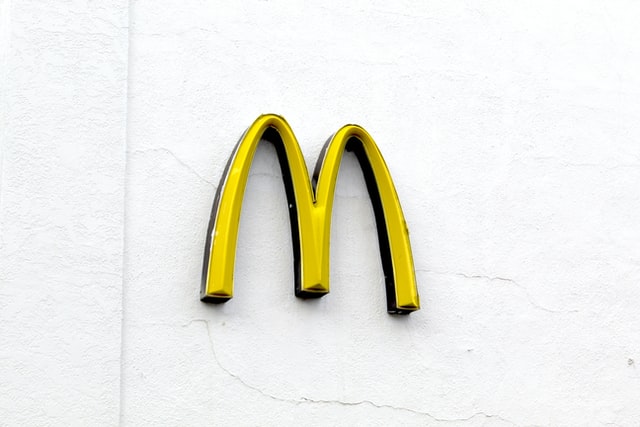As you wander around München or Berlin city centre, possibly carrying a few shopping bags in your hands, you realise it is one o’clock. Time to grab some lunch?
With fast food signs scattered all over the main streets, you can’t help but feel hungry. Is it simply your stomach being greedy? Not completely. Your subconscious, in truth, is making your mouth water too.
Fast-food restaurants have been using colour psychology for years, with the ultimate goal of attracting potential clients. By evoking specific feelings in your mind, they want you to step inside their spot to dig into a würstel, snack on a pretzel, or sip a cold beer.
Electrix, expert manufacturer of Gitterrinne, has explored the colour schemes used in brand logos of 50 international fast-food restaurants. Why and how do they have an impact on their success?
White
For obvious readability problems, the colour white cannot be used on its own. However, it can offer brand images a perfect, clean backdrop. Likewise, it saves colourful logos from being too chaotic, providing them with a touch of order and simplicity.
It is no surprise that it is one of the most popular colours. In fact, out of the 50 brands we evaluated, 20 have selected the colour white as an integral part of their brand’s logo.
Black
Once disregarded as an unappealing colour, black has slowly been re-evaluated. Now, it is a common choice for restaurants and fast-food chains. Indeed, 16 out of 50 logos adopt black features within their design. But why is it so popular?
Firstly, no other colour guarantees better readability, especially against a white background. Secondly, black evokes a sense of elegance, class, and sophistication. It increases people’s perception of value and high quality, just like a refined black truffle. As fashionistas will agree, black is always a safe bet!
Red
When it comes to arousing an appetite and desire for food, red is the king of all persuasive colours. Widely renowned as the tint of passion and power, accelerating both your nerve impulses and your heartbeat, red also increases your hunger and stimulates a physical response. No wonder it is the most frequent colour shade on fast-food packaging and restaurant logos!
32 brands out of our 50 used tones of red in their brand design. With your neurons in jubilation inside the brain’s hypothalamus, you will immediately associate this evocative colour with sweet goodness and juicy meat. In short, this is why you will struggle to restrain your hunger.
Orange
Similar in shade and warmth to the colour red, orange activates impulses to eat and stimulate senses too. Ultimately, it does exactly want a restaurant wants. Because it lends itself well as an appetising colour, orange features in 9 out of the 50 fast-food restaurants we have examined.
What’s more, the colour orange seemingly symbolises affordability. This is a great expedient for fast food chains that aim to welcome diners that are in search of a reasonably priced meal.
Yellow
Just like the colour white, yellow cannot be left to its own devices, as potential customers may struggle to read the restaurant’s name. Hence, it is mainly used as an effective and faithful companion of red logos or is simply partnered up with other darker colours.
The beauty of yellow, though, is that our brain can process it faster than any other colour, and has the ability to immediately capture the attention of possible clients. Moreover, it has been found that the colour yellow releases a feel-good chemical called serotonin. What this suggests is that, while enticing consumers from the outset, it has also the power to make people happy with the meal they have just purchased.
With an array of uplifting connotations, it is no surprise to discover that 15 brands out of 50 brands have decided to use the colour yellow to promote their fast-food restaurant.
Blue
Blue may well be German men’s favourite colour when it comes to fashion, but it certainly does diners no favours.
Can you think of any natural blue foods? Except for blueberries, probably not. It may spark memories of mould on an expired loaf of bread – but that’s certainly not very appetising. In short, research suggests that the colour blue tends to be an obstacle for feelings of hunger.
That said, if handled carefully, it can still work. Blue portrays a sense of trust and dependability, which are two sentiments that restaurants are more than happy to be aligned with. Naturally, given that it is a popular colour, 11 brands out of 50 ended up opting for blue in their design.
Green
As consumers continue to learn the importance of sustainability, green is the colour generally chosen to indicate health and well-being. Because of its immediate correlation with parks, nature, and the environment, green tends to invoke feelings of calm and relaxation.
9 brands out of 50 have adopted green features in their logo. Is it an implicit invitation to sit down at the restaurant table and unwind? It’s an offer you just cannot refuse.
Purple and pink
It is fair to say that pink and purple are not the most popular colour options, as only two fast-food restaurants chose pink and only one has chosen purple to use in their design. On one hand, pink stimulates a desire for sugar and sweets and, therefore, is more in line with dessert-selling locales.
On the other, purple tends to evoke feelings of wisdom and spirituality. Possibly, not emotions that take priority in a fast-food chain’s mission. However, if a restaurant is on the lookout for an original, memorable design, it is the perfect shade to steer away from the usual warm colours.
Fast-food restaurants, over the years, have worked hard on the style, colour, and composition of their brand logos. If your stomach starts rumbling in the street, bear in mind that it is not just you being greedy. It is colours working their magic.
Sources
https://www.insider.com/fast-food-colors-make-you-hungry-2018-9


